The 1989 Lincoln cents aren’t among the rarest or most desirable coins in the series. In general, their value remains modest due to their high mintage and common composition of zinc coated with copper. Most examples sell for less than $2, unless they’re in exceptionally well-preserved condition.
Despite their lack of rarity, these coins can still be an interesting addition to a collection—especially in pristine states. Over time, high-grade specimens may gain in value, making them worth holding onto.
1989 Penny Value Chart
| Grade | 1989 No Mint Mark (Philadelphia) | 1989-D (Denver) | 1989-S Proof (San Francisco) |
|---|---|---|---|
| MS 65 Red | $10 | $14 | — |
| PR 65 Red | — | — | $4 |
Values shown are for Red-designated coins, meaning they retain their original copper brilliance with no discoloration.
Why Are 1989 Pennies So Affordable?
- Massive production: More than 11 billion were minted across all facilities.
- Low metal value: Made primarily of zinc (97.5%) with 2.5% copper plating.
- Not a key date: No major rarities or key-date status for this year.
Collector’s Tip
If you come across a 1989 penny graded MS67 or higher with strong red color, it could command a much higher price at auction. In some cases, coins with rare mint errors or deep cameo proof quality can be significantly more valuable.
For serious collectors or those hoping for future appreciation, certifying high-grade coins might be a smart investment.
History of the 1989 Memorial penny

Abraham Lincoln, the 16th President of the United States, is remembered not only for leading the Union to victory during the Civil War, but also for abolishing slavery, strengthening federal authority, and helping to modernize the American economy. His legacy made him the first real historical figure to be featured on a U.S. coin — a break from tradition, especially since George Washington himself once opposed placing leaders on currency.
Evolution of the Lincoln Cent Design
- 1909: The Lincoln cent was first issued to honor the 100th anniversary of Lincoln’s birth (born February 12, 1809).
- 1959: The reverse was redesigned to feature the Lincoln Memorial, marking the 150th anniversary of his birth.
- 2009: Special Lincoln Bicentennial cents were introduced with four unique reverse designs.
- 2010–Present: The U.S. Mint transitioned to the Shield reverse design, which is still in use today.
1989 Memorial Penny Mintages
| Mint Location | Type | Mintage |
|---|---|---|
| Philadelphia | 1989 penny (no mint mark) | 7,261,535,000 |
| Denver | 1989-D penny | 5,345,467,111 |
| San Francisco | 1989-S proof penny | 3,220,194 |
| Total | — | 12,610,222,305 |
These figures reflect just how widely circulated the 1989 Lincoln cents were, making them common in everyday change. Still, special attention to mint marks, grades, and possible errors can help collectors find hidden gems among them.
Features of the 1989 Memorial penny
The obverse of the 1989 penny
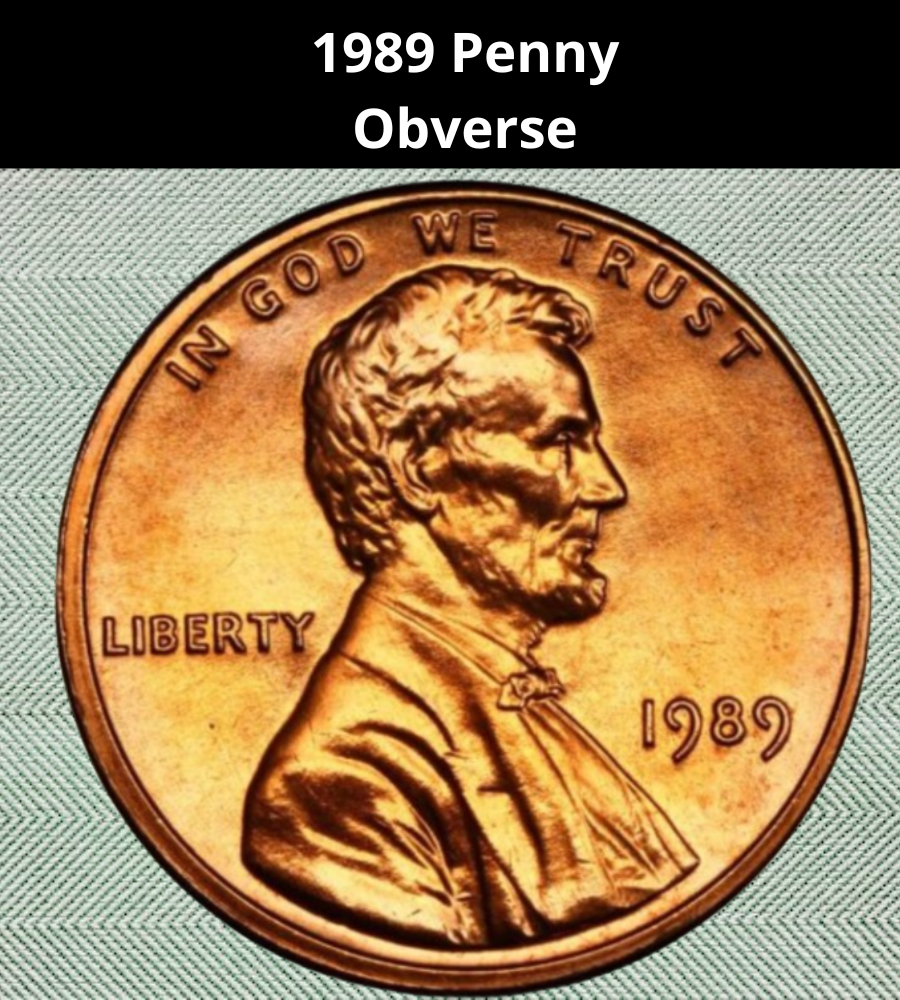
The obverse of the 1989 penny closely mirrors the original design introduced in 1909 to honor President Abraham Lincoln, who was tragically assassinated in 1865. His right-facing bust remains the focal point of the coin’s front.
At the top, the national motto “IN GOD WE TRUST” arches over Lincoln’s head. On the left, you’ll find “LIBERTY”, while the year “1989” and the mint mark (if any) appear to the right, just above the shoulder.
An important detail lies at the base of the bust—the designer’s initials, “VDB”, short for Victor David Brenner, are engraved subtly at the shoulder cut-off. These initials had sparked significant public debate upon the coin’s initial release, but eventually earned their rightful place back on the design.
The reverse of the 1989 penny
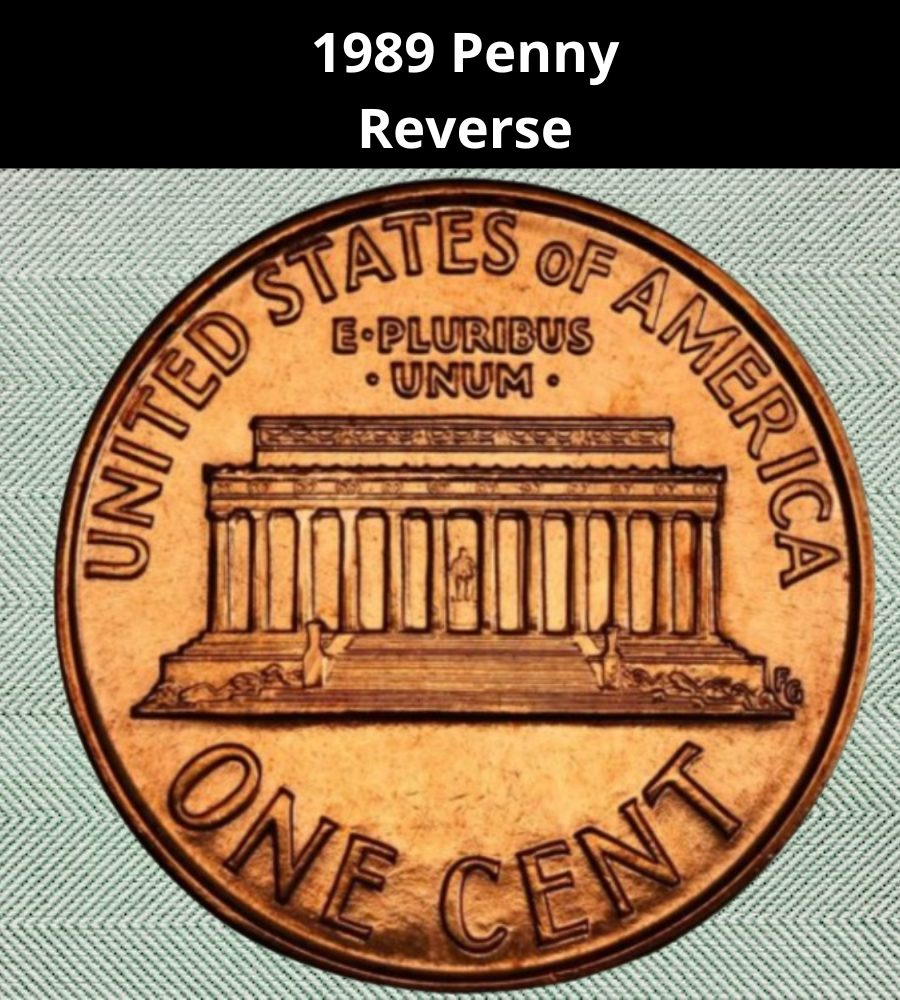
Unlike the original Wheat pennies struck from 1909 to 1958, the 1989 Lincoln cent features the Lincoln Memorial on its reverse. Designed by Frank Gasparro, this version offers a unique artistic detail—a tiny depiction of President Lincoln seated inside the Memorial, clearly visible between the central columns.
The reverse design is framed by the inscription “UNITED STATES OF AMERICA” at the top and the denomination “ONE CENT” at the bottom. Just beneath the country’s name is the Latin motto “E • PLURIBUS • UNUM”.
To the right of the Memorial’s base, you’ll notice the initials “FG”, paying tribute to the designer Frank Gasparro.
1989 Lincoln Penny Specifications
- Shape: Round
- Edge: Plain
- Face Value: One Cent ($0.01)
- Composition: 97.5% zinc, 2.5% copper (copper-plated zinc)
- Diameter: 19.05 mm (0.75 inches)
- Thickness: 1.52 mm (0.05986 inches)
- Weight: 2.5 grams (0.08818 ounces)
Additional Features of the 1989 Lincoln Memorial Penny
The 1989 Lincoln penny, featuring the Lincoln Memorial on the reverse, is a classic round one-cent coin with a plain edge. Like all Lincoln cents minted after 1982, its composition is primarily zinc (97.5%) with a thin copper coating (2.5%).
In 1982, the U.S. Mint reduced the coin’s weight from 0.1097 ounces (3.11 grams) to 0.08818 ounces (2.5 grams) — even lighter than the steel cents produced during WWII, which weighed 0.09524 ounces (2.7 grams).
Despite this change in composition and weight, the dimensions remained consistent. The 1989 penny still measures 19.05 mm (0.75 inches) in diameter and has a thickness of 1.52 mm (0.05986 inches).
1989 Lincoln Memorial Penny Grading Guide
To accurately determine the value of your 1989 Memorial penny, it’s highly recommended to have it professionally graded by a trusted coin grading company. While most circulated examples hold little value, high-grade specimens can be worth significantly more. For general reference, collectors and dealers use the Sheldon Grading Scale, which evaluates coins from 1 to 70 based on their condition.
Grading Scale Overview (Sheldon Scale)
| Grade Number | Grade Name | Description |
|---|---|---|
| 1 | Basal State-1 | Barely recognizable; heavily worn |
| 2 | Fair | Identifiable but nearly flat |
| 3 | Very Fair | Some details visible, still very worn |
| 4–6 | Good | Major design elements are clear but flat |
| 7–10 | Very Good | More detail visible, moderate wear |
| 12–15 | Fine | Moderate detail; wear on high points |
| 20–30 | Very Fine | Bold details with slight flatness |
| 40 | Extremely Fine | Sharp design with minor signs of wear |
| 50 | About Uncirculated | Nearly mint state, slight high-point wear |
| 60 | Mint State (MS 60) | Uncirculated with noticeable marks |
| 65 | Gem Mint State (MS 65) | Attractive, minimal flaws, bright luster |
| 70 | Perfect Mint State (MS 70) | Flawless under magnification |
Tip: Lower-grade coins are generally worth only face value or slightly above. If your coin shows no visible signs of wear and has a strong, lustrous appearance, it may be worth grading—especially if it’s MS 65 or above.
1989 Penny Value Guides
In 1989, the total production of Lincoln Memorial pennies reached an impressive 12,610,222,305 coins. This total includes:
- Regular strike coins from the Philadelphia and Denver mints
- Proof coins bearing the “S” mint mark, produced at the San Francisco Mint
These figures reflect the U.S. Mint’s large-scale coin production during the late 20th century, ensuring the 1989 penny remains a common but historically significant part of American numismatics.
1989 No Mint Mark penny Value
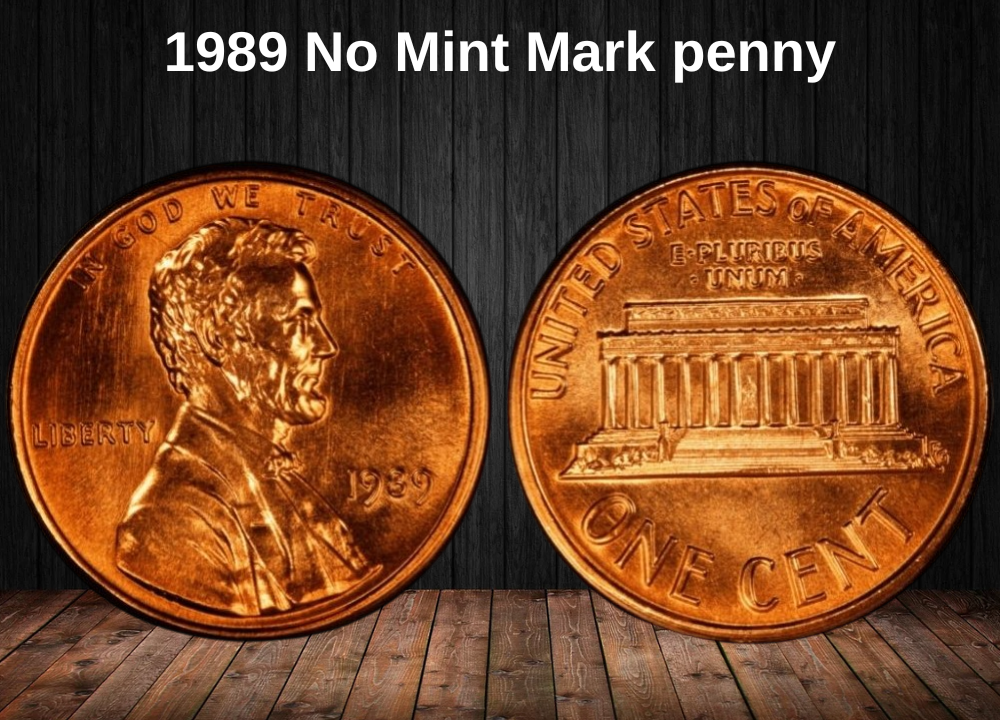
Lincoln Memorial cents struck at the Philadelphia Mint in 1989 are generally inexpensive, with values typically ranging from $0.10 to $2, depending on condition. However, red examples in higher grades like MS 66 or MS 67 can be worth $14 to $45 in today’s market.
Among the massive mintage of 7,261,535,000 coins, only a few top-tier examples graded MS 68 have survived. These elite coins are valued at up to $425 by professionals. Remarkably, one such specimen set a record auction price of $4,113 in 2013, making it a standout in the series.
1989 S Proof Penny Value
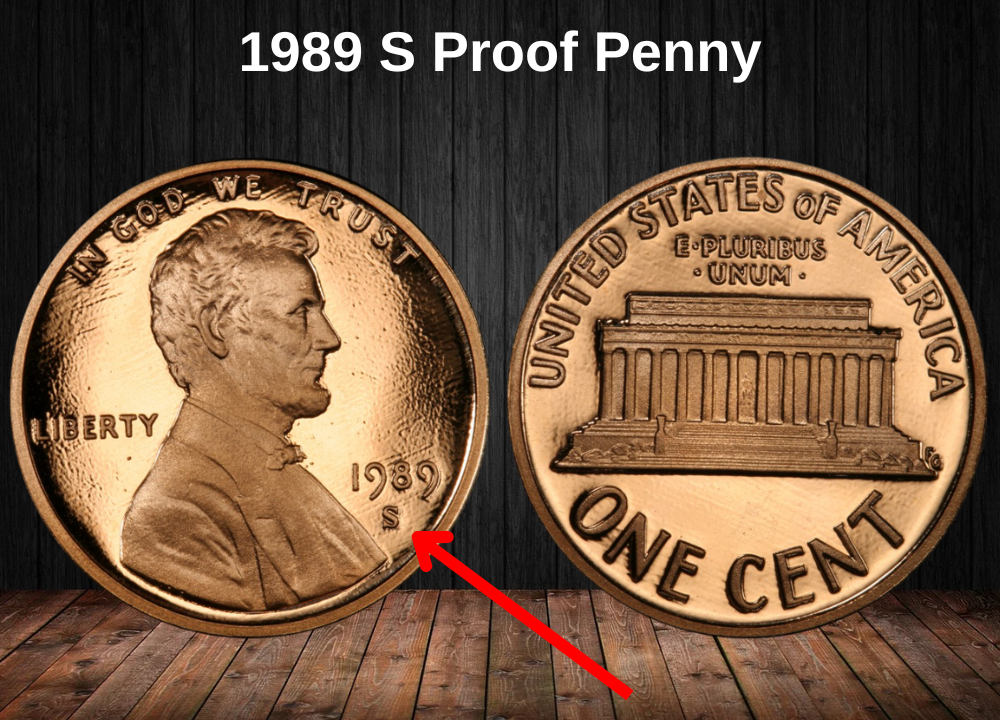
In 1989, the San Francisco Mint produced only proof pennies, with a limited mintage of 3,220,194 coins. Collectors tend to focus on examples with deep cameo (DCAM) contrast, though even these remain modestly priced.
Most red proof coins graded between PR 60 and PR 65 typically sell for around $1 to $4. Even in higher grades like PR 66 to PR 69, prices stay affordable, ranging from $5 to $14, making them accessible for beginner and experienced collectors alike.
1989 D Penny Value
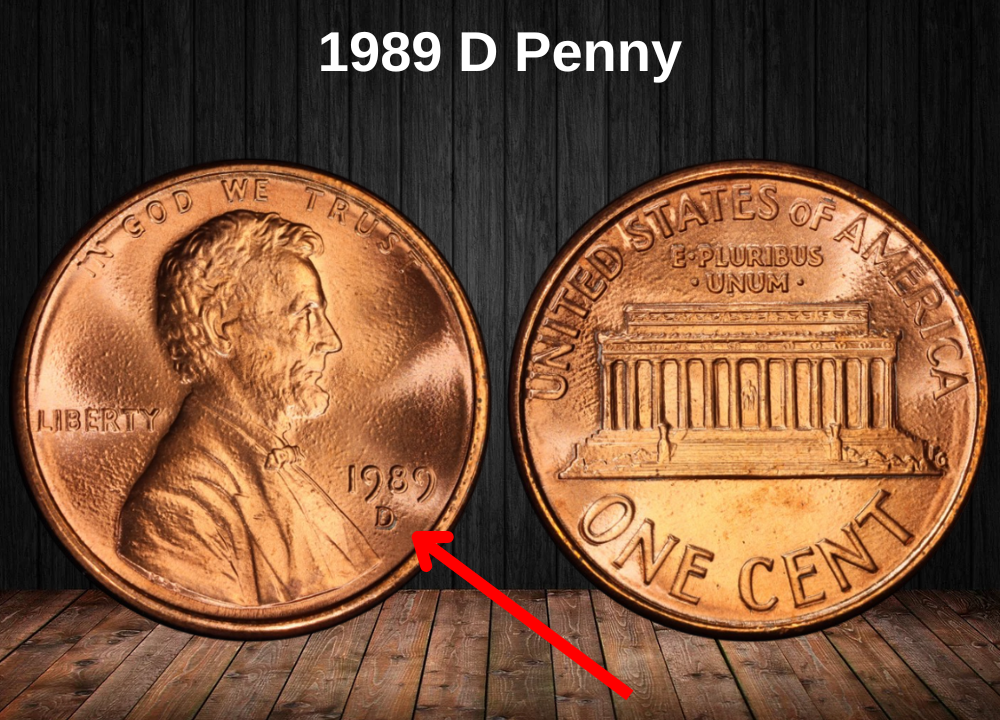
The Denver Mint struck an impressive 5,345,467,111 pennies in 1989, making it one of the top producers that year—though still behind Philadelphia in total output. Despite the high mintage, most coins in lower uncirculated grades remain very affordable. A red example graded MS 60 can typically be found for around $0.10.
Coins in slightly better condition—from MS 61 to MS 67—range in value between $0.12 and $25, depending on luster, strike quality, and preservation. In MS 68, their value climbs to around $300.
While experts estimate that an MS 69 red Denver penny could fetch up to $10,000, actual sales have been lower. One such coin, featuring vibrant red toning, sold for $1,024 at auction in 2020, setting a more realistic benchmark for top-tier specimens.
Rare 1989 Penny Errors List
Off-center
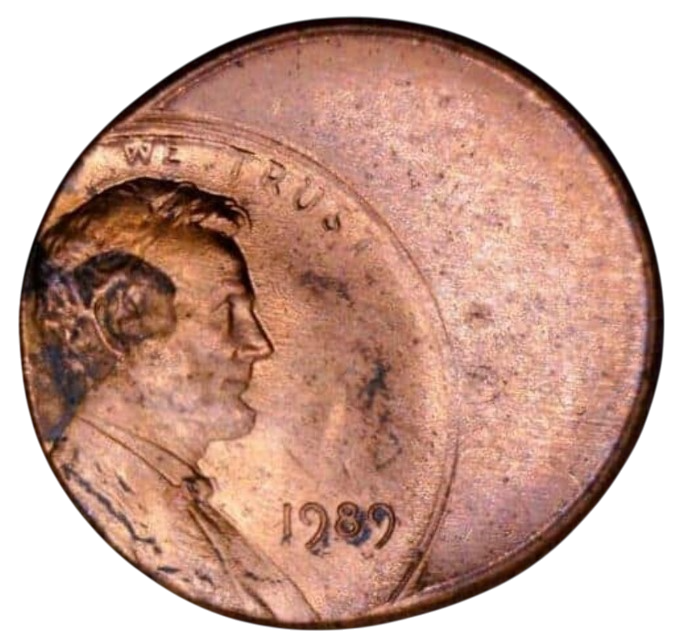
An off-center error occurs when the coin isn’t correctly aligned between the dies during striking. As a result, part of the design is misaligned or missing, and the severity of the shift is expressed as a percentage.
The least dramatic examples—those with a 3% to 5% misalignment—are typically the least expensive. In contrast, coins with a 10% to 20% off-center strike are more noticeable and can sell for around $20 to $90.
Collectors especially value pieces that are 45% to 65% off-center, as they display significant visual impact while still retaining important details like the date. Even coins with greater deviation can be desirable as long as the date is clearly visible, ensuring their collectibility and market value.
Penny struck on a dime planchet
Occasionally, due to human error during the minting process, a dime planchet was mistakenly fed into the coin press intended for pennies. The result is a strikingly unusual error coin that stands out immediately due to its unusual appearance.
These error pennies are noticeably lighter and smaller than regular ones. Instead of the standard 2.5 grams (0.08818 ounces), these weigh only 2.268 grams (0.08 ounces). Their diameter is also reduced, measuring just 17.91 mm (0.705 inches), compared to the usual 19.05 mm (0.75 inches).
Because of the size mismatch, these coins are often incomplete, with partial or missing inscriptions along the edges. Another giveaway is their silver-like color, caused by the dime planchet’s composition, which contrasts sharply with the typical copper appearance of standard Memorial cents.
These error coins are relatively rare and highly collectible. Depending on their condition, they typically sell for $350 to $700 on the market.
Penny struck on a copper planchet
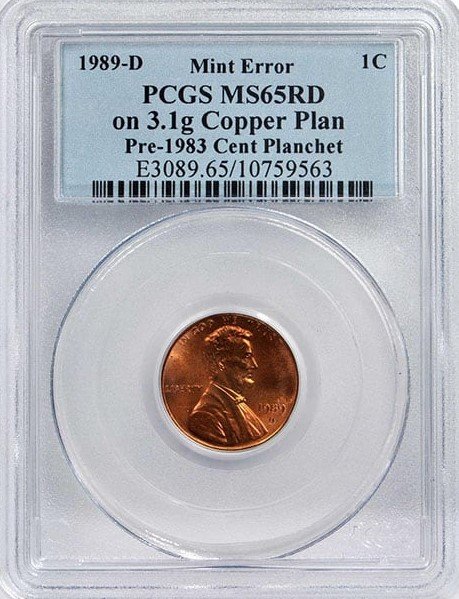
While most 1989 Lincoln cents were struck on a zinc planchet coated in copper, a few rare examples from the Denver Mint were mistakenly produced using solid copper planchets—a leftover material from the pre-1982 era.
This minting error was quickly identified by workers, but a small number of these copper-based coins still made their way into circulation. These pieces can be identified by their heavier weight—approximately 3.11 grams instead of the standard 2.5 grams—and their solid copper composition.
Because of their rarity and the collector demand for transitional errors, these 1989-D copper pennies are highly valuable. Depending on condition, they can fetch anywhere between $3,500 and $7,500 at auction or through private sales.
Fold-Over Strike
This error occurs when the blank (planchet) is mispositioned during the strike, causing it to bend or fold unnaturally. These unusual, deformed pennies are quite rare and highly sought after by error coin collectors. Their value typically ranges between $960 and over $1,200, depending on condition and completeness of the strike.
Obverse Cud Break
As coin dies age, they can develop cracks or break, which results in extra metal blobs or raised areas on the coin surface. A cud break on the obverse (front) of a 1989 penny often appears as a raised, irregular shape or line, typically near the rim. Coins with this error can be worth up to $100.
Doubled Die (DDO or DDR)
A doubled die error occurs when the die itself has a misaligned impression of the coin design. On 1989 pennies, DDO (Doubled Die Obverse) or DDR (Doubled Die Reverse) examples are relatively common, and usually sell for around $10 to $15. However, rarer tripled or quadrupled die errors may command higher premiums depending on visibility and grade.
Double-Struck with Indent
Sometimes, the coin press strikes a planchet twice—the second strike happening before the first coin is fully ejected, resulting in a double image or overlap. If an indent is visible where two planchets overlapped during the strike, this error becomes even more desirable. High-quality examples of this error can be worth around $150.
Die clash
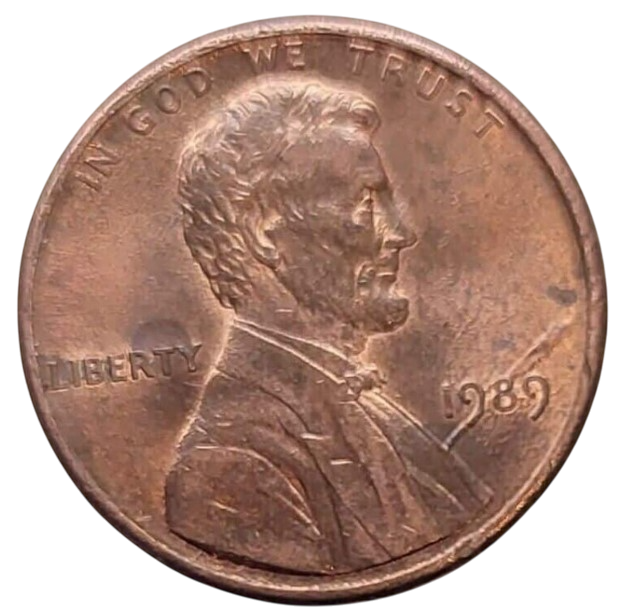
A die clash error happens when the coin press activates slightly too early or too late, causing the obverse and reverse dies to strike each other directly without a planchet in between. As a result, the dies imprint parts of their designs onto one another.
When a properly timed planchet is eventually placed and struck, it can show faint or partial design elements from the opposite die—for example, details of the reverse on the obverse side, or vice versa.
These coins are considered mint errors, and while not extremely rare, they are quite interesting to collectors. A 1989 penny with a visible die clash can typically sell for around $20, depending on the visibility and clarity of the clash marks.
Improper Annealing Error
Some 1989 pennies minted in Denver show signs of an improper annealing process—a key stage where coin blanks (planchets) are repeatedly heated and cooled to make them malleable for striking.
When this process is not done correctly, the resulting coins often appear partially discolored, typically showing dark or uneven toning. These errors are noticeable and collectible, with values generally higher than face value, though not extreme. A 1989 penny with this error can be worth significantly more than regular issues, depending on the severity and eye appeal.
Clipping Error
A clipping error occurs when a blank is misfed into the cutting press, often due to the previous blank not fully ejecting. This causes part of the next coin to be cut off, resulting in a distinctive curved or straight clip on the edge.
While clipped planchets from certain years can be rare and valuable, the 1989 versions are relatively common. These coins typically sell for about $30, depending on the size and shape of the clip and whether the date is still fully visible.
Where to sell your penny?
Now that you know the value of your penny, you might be wondering where to sell it. Don’t worry: here’s a guide to some of the best online platforms where you can easily sell your coins, along with their advantages and disadvantages.
Discover the best platforms for selling coins online (pros and cons).
FAQ about the 1989 penny
1. What major design revision occurred on the 1989 penny’s reverse and how does it impact collectors?
The reverse design of the Lincoln Memorial cent was subtly modified in 1989, specifically the designer’s initials “FG” (Frank Gasparro). The G lost its serif, and the initials were repositioned further from the base of the Memorial. This change is important because it created a visual shift in the series and helps identify transitional errors in prior years (like the 1988-D Reverse of 1989).
2. Are there any known valuable varieties or errors specific to the 1989 penny?
Yes. While not as famous as earlier years, 1989 pennies can feature doubled dies, especially on the obverse in the “LIBERTY” or “IN GOD WE TRUST” inscriptions. There are also examples of die cracks, off-center strikes, and clipped planchets that add collectible interest.
3. What makes a 1989 Lincoln cent especially desirable to collectors?
The most desirable 1989 cents are those with:
- MS-67 Red (RD) or higher grades
- Full strike details, especially sharp steps on the Memorial
- Error varieties, such as doubled dies or off-metal strikes
Coins that show exceptional luster and no spotting command premiums, especially in PCGS or NGC holders.
4. What are the diagnostics of a high-quality 1989 Lincoln penny suitable for third-party grading?
Look for:
- Strong strike on both obverse and reverse.
- Clean fields with minimal contact marks.
- Bright, even copper red (RD) color.
- No signs of plating bubbles or zinc corrosion, which are common on post-1982 cents.
5. What impact did the 1989 reverse design change have on future Lincoln cents?
The 1989 redesign set the standard for all Lincoln Memorial cents until the series ended in 2008. It marked a final evolution in the Memorial reverse before the bicentennial redesigns of 2009, making the 1989 penny a transition point in the series.
6. Are there off-metal errors involving 1989 pennies, and how rare are they?
Off-metal errors, such as 1989 cents struck on dime planchets (resulting in smaller, silver-colored coins), are very rare but do exist. These types of errors are highly sought after and require authentication due to their potential value.
7. How does the composition of the 1989 penny affect its longevity and condition in circulation?
Like all post-1982 cents, the 1989 penny is made of zinc with a thin copper plating. This makes it susceptible to corrosion and bubbling if exposed to moisture. Collectors often see these issues on circulated examples, which is why pristine red uncirculated coins are more valuable.


















































